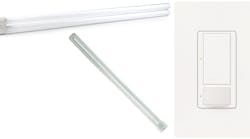Over the past several months, rebate organizations across the country have been busy updating their programs for 2018. BriteSwitch has waded through the data and identified the following trends to watch this year.
LED Rebate Amounts Start to Level Out
Historically, rebates for LED lighting have decreased 10% to 20% every year. This year, the rebate amounts have started to level out; the average prescriptive rebate for LED only went down 1% across all product lines (see the Figure below). That being said, some specific products saw some big changes. LED linear tube replacements dropped by 19% and screw-in HID replacement lamps fell by 35%. These decreases likely reflect the changing price in the marketplace as the costs of those solutions have also decreased significantly in the past year. In contrast, rebates for LED downlights and linear panels (2×4s) rose 5% and 10%, respectively.
Rebates for DLC Standard vs Premium
A Design Lights Consortium (DLC) rating has always been important for LED rebates with about 80% of programs requiring it. In 2017, DLC introduced a new “DLC Premium” category. Products must meet higher qualifications and testing requirements to be considered for the premium classification.
It’s been unknown how utilities would adapt their programs to this classification. Looking at the current rebate landscape, DLC premium has not had a significant impact. Only a handful of programs require the DLC Premium qualification to get rebates. More commonly, programs offer an additional rebate or bonus if using a DLC premium product instead of a standard. The amount is usually an additional $10 to $20, so it doesn’t always cover the added cost of using a premium product. Right now, these extra incentives are offered in less than 10% of LED rebates.
Control Rebates Are Strong as Ever
Rebates for controls like occupancy sensors, daylight dimming, and lighting controls are still remarkably strong. In fact, since we have been tracking rebate changes over the past eight years, rebates for controls is the only category that has not decreased at all. For products like luminaire-mounted and remote-mounted occupancy sensors, the average rebate is still high ($20 to $30) compared to cost. In many cases, the rebates make sensors an attractive and cost-effective addition to most lighting upgrades.
With the addition of a new DLC category of networked lighting controls, some programs are starting to offer more rebates for these systems. Because many networked lighting controls are more complex than stand-alone sensors, many other rebate programs are still trying to figure out how to best implement them.
Biax / PL-L Lamps and 8-Foot Tubes
Later this year, DLC will be finalizing its criteria for several popular types of lighting, such as 3-foot tubes, 8-foot tubes, and Biax/PL-L lamps as well as up-and-coming technologies, such as color-tuning fixtures. These categories represent some much-needed additions where rebates have fallen behind due to lack of a DLC category. Because of the mid-year launch of the these new DLC categories, we don’t expect widespread adoption of prescriptive rebates until 2019. In the interim, once these products start appearing on the DLC list, there will be potential for custom rebates for these solutions. Custom rebates are generally more complicated to pursue than prescriptive rebates, and basically need to be reviewed on a case-by-case basis.
Young is the operations manager for BriteSwitch, Princeton, N.J. He can be reached at [email protected].
Sidebar: Things to Keep in Mind for LED Rebates
Depending on your location, you may be eligible for a sizable rebate when installing LED solutions in an existing facility or on a new construction project. Consider the following:
Product Eligibility
Rebate programs often have requirements that products must meet in order to qualify. They may require a certain wattage, shape, warranty, or listing by an organization, such as Energy Star or Design Lights Consortium.
Pre-Approval and Timing
Many programs require that you receive pre-approval before you purchase or install any lighting. As of this writing, the average time it takes to get pre-approval across North America is 29 days. Make sure to start the process early so you don’t miss out on any money.
Cost Caps
Some programs may advertise a flat $40 per lamp rebate, but often these rebates are capped at a certain percentage of project cost. Other programs may promise a rebate of “up to” a certain percentage in project cost, but it will be limited by the financial payback time of the project.




